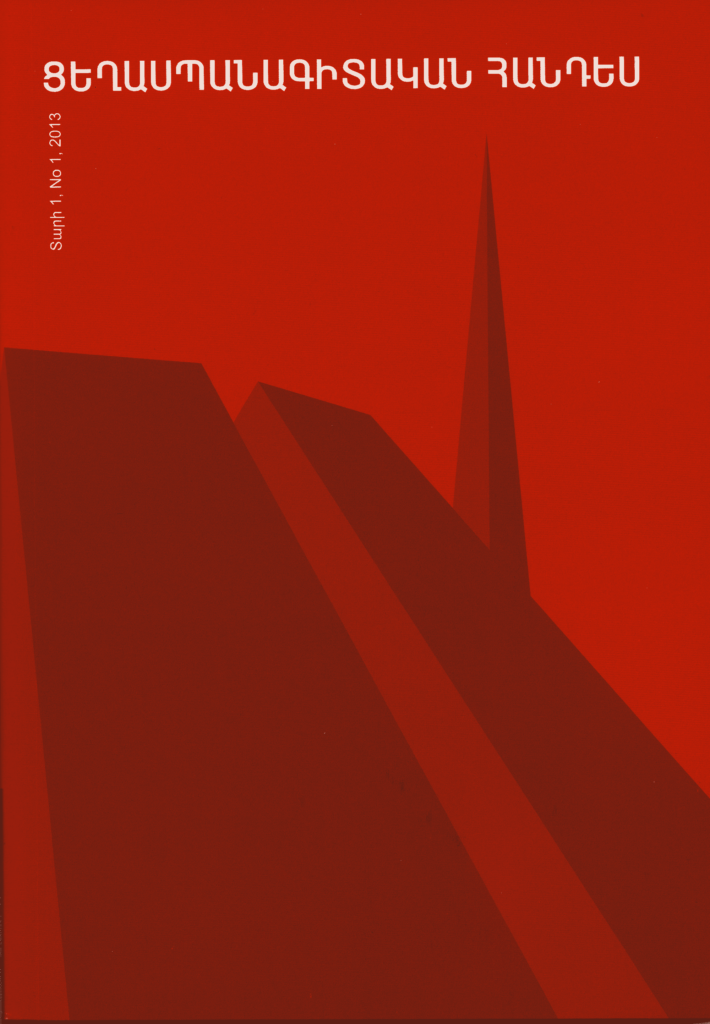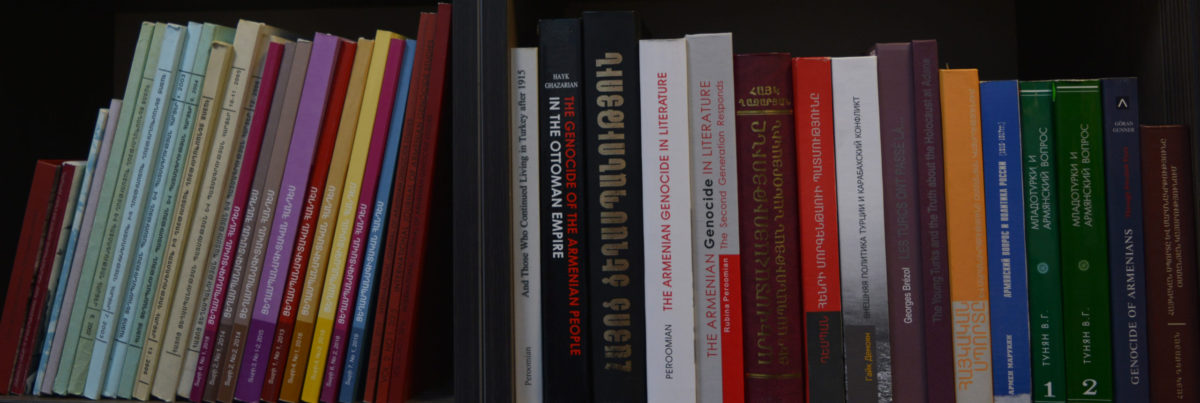
Ts՚eghaspanagitakan handes (“Journal of Genocide Studies”)
Anna Aleksanyan
Pages 7-14
Abstract
After 1909 massacres the Ottoman Armenians did their best to help those who suffered during Adana massacres. The Armenian women were also involved in the relief mission to
help orphans, widows and prisoners. Many witnesses published voluminous works, articles trying to assess the situation and to find out real organizers and causes of the massacres. In this respect, the works of Zabel Esayan and Arshakuhi Teodik present very important sources as an eyewitness account. The authors referred the Western Armenian women, who played an active role in supporting Cilician Armenians after the disaster. Armenian female activists gave their own appreciation of the situation in their works, memoirs and letters.
Received on June 12, 2013
Published on September 20, 2013
Arpine Bablumyan
Pages 15-23
Abstract
The article reveals the main features of population changes after Cilician massacres of 1909. After these massacres the number of Armenian population in the provinces of Adana and Aleppo decreased drastically. The Adana massacres resulted in:
1. mass killings,
2. deaths from starvation and illness
3. cases of forced conversion to Islam,
4. absolute loss of the Armenian population in some settlements with former large number of Armenians
5. Immigration.
Received on June 5, 2013
Published on September 20, 2013
Aramayis Baloyan
Pages 24-33
Abstract
The Italian diplomats, who eyewitnessed the massacres of the Armenian population in the provinces of Adana and Aleppo in April of 1909, have passed very notable information to the Italian government. In their telegrams and diplomatic dispatches they have clearly emphasized the fact that the Armenian massacres had been organized and implemented by the Young Turkish government. These documents mostly unknown to the researchers until recently. Now by putting these documents into circulation, we’re sure that they will strongly contribute to the comprehensive study of the problem.
Received on July 9, 2013
Published on September 20, 2013
Hayk Demoyan
Pages 34-41
Abstract
1909 Adana massacres heralded the real intention of the Young Turks for total annihilation of the Armenian population of the Ottoman Empire, seeing it as the only way to solve the Armenian question. The massacres left a great psychological impact on the Armenians, both in Ottoman Empire and worldwide, thus creating the athmosphere of insecurity and expectation of the forthcoming major massacres. It also created a huge wave of emigration of the Armenians from the Cilician region.
Massacres touched the excitement of the Armenians who reacted positively to the overthrow of the “Red Sultan” Abdul Hamid II in 1908 who was a symbol of the Turkish tyranny and massacres. Inhuman treatment of the Cilician Armenians and, especially the participation of the Army of Revolution in the massacre led to the conclusion that the change in regime in the Ottoman Empire did not bring any positive alteration in the approach of the Turkish government towards the Armenians. Moreover, Young Turks continued the anti-Armenian policy of the Sultan which resulted in the state organized and implemented Genocide against the Armenian subjects of the Ottoman Empire during 1915-1918.
Received on June 21, 2013
Published on September 20, 2013
Raymond Kévorkian
Pages 42-58
Received on May 30, 2013
Published on September 20, 2013
Tatevik Ghaltakhchyan
Pages 59-68
Abstract
The Armenian massacres of April 1909 organized in Adana and surrounding regions were covered intensively in the Western Armenian press. The media outlets show that the information on the massacres in Adana and neighboring regions, organized by the Hamidian regime, were dominant in the Western Armenian press. Later most of the publications in the Western Armenian press tried to convince the society that the massacres were organized and provoked by the leaders of Young Turks and the government itself. In addition, Turkish regular army directly participated in the massacres of these period. In response to the baseless attempts of Young Turks’ government to represent the Armenians as guilty in the massacres the Armenian press published many opposing articles. The Young Turks ignoring their promises given during the revolution limited the freedom of speech by resuming the persecution of the Western Armenian printed media.
Received on May 30, 2013
Published on September 20, 2013
Suren Manukyan
Pages 69-75
Abstract
In the beginning of XX century the difference between retarded Moslem and modernized, innovative Armenian communities was clearly visible. This gap brought envy and hatred against the Armenians and became one of the reasons of 1909 Adana massacres. For centuries, the Turks perceived Armenians as subjugated, second-class citizens, who created goods and treasures for the Empire. However after the proclamation of 1908 Constitution this superior inferior division de jure disappeared and the existence of Armenians and other non-Turkish nations became “useless”. As long as Armenians accepted their old status and avoided claiming for equality with Muslims they could hope to remain secure and safe. The spread of capitalism, modernization, and reimplementation of the Constitution opened up new opportunities for Armenians. Possible change of public status reasoned violence.
Received on June 19, 2013
Published on September 20, 2013
Éva Merénics
Pages 76-91
Received on June 28, 2013
Published on September 20, 2013
Aram Mirzoyan
Pages 92-97
Abstract
Coup d’etat of Young Turks in 1908 raised a wave of hope among the subjected nations of the Ottoman Empire including Armenians who suffered the most during the reign of Sultan Abdul Hamid known as “Red Sultan”. But the Cilicia massacres in April 1909, when 30.000 Armenians were killed, made them to rethink their expectations.
As a result many Armenian children became orphans. Unlike the Armenian massacres of 1894-1896 Ottoman government allowed Armenians to launch relief work. Furthermore, it allocated some money for this work and opened several state orphanages.
This article presents Armenian relief activities after the Adana massacres in 1909.
Received on July 3, 2013
Published on September 20, 2013
Seda Parsamyan
Pages 98-104
Abstract
Numerous facts testify that during the Hamidian massacres of 1894-1896, and the Adana massacres of 1909, as well as during the Armenian Genocide (1915-1923) massacres were accompanied by the destruction of the Armenian cultural monuments, values; namely, the demolition of schools and historical-architectural monuments, which completely fits with the description of the cultural genocide. This article observes the methods of the destruction of the educational-cultural and religious buildings in Adana and its consequences. During the 1909 massacres the Turkish perpetrators saw the Armenian religious-cultural buildings as appropriate places for implementing their genocidal action, which though uncontrollable, yet included certain ceremonial, religious and ritual elements and by targeting them, the Turkish perpetrators also aimed to disgrace the Armenian religious-cultural establishments.
Received on July 11, 2013
Published on September 20, 2013
Rubina Peroomian
Pages 105-117
Received on July 24, 2013
Published on September 20, 2013
Varuzhan Poghosyan
Pages 118-127
Abstract
This article refers to the elucidation of the 1909 massacres of Cilicia in French historiography. The author divides the French historiographical literature into three main groups£ documentary publications, works elucidating the history of the main event and researches dedicated to the history of the Ottoman Empire where the history of the massacres of Cilicia was interpreted to some extent. The author concludes that the history of the 1909 massacres of the Armenians in Cilicia, in general, remains the step-child of the history in France as well as in the modern historiography of the Armenian Genocide.
Received on June 19, 2013
Published on September 20, 2013
Harutyun Selimyan
Pages 128-137
Abstract
This article shows the losses of the Armenian evangelics as a consequence of Adana massacres. The author presents the details of the Adana massacres, human and material losses, the pain and grief of the Armenian people; he exhorts not to be naive in essential national questions, on the contrary always to be realistic and long-sighted, reasonable and wise. The author advises to ask for help from the foreigners, but not to expect a salvation and to acquire rights by own means; to be united and to have will, to evaluate the present and to step towards the future with unshakable belief.
Received on August 2, 2013
Published on September 20, 2013
Hasmik Stepanyan
Pages 138-141
Abstract
The author highlights the necessity of a research of the Turkish literature written in Armenian letters which includes the Armenian documentary material on the history of the Ottoman Empire, different spheres of its people’s life. He reverts to the role of Turkish in Armenian letters to save it from estrangement, to reestablish the Armenian originality and the speaking of the Armenian language and to be faithful to the apostolic religion. Information about the 1909 massacre in Adana spread in abroad through the Turkish press printed in Armenian letters.
Received on August 14, 2013
Published on September 20, 2013
Ani Voskanyan
Pages 142-147
Abstract
1909 Adana massacres during which more than 30 thousand Armenians fell victim were organized and perpetrated by the central government of Young Turks. During the massacres the arsenals were opened and the crowd was armed by the instruction of the government. The second carnage which happened under the pretext of the establishment of a “law and order” was committed by the assistance of the Liberation army, which itself confirmed the direct involvement of the government in the organization of the massacres.
Thus, the constitutional liberation army committed Adana massacres by the order of the central government.
Received on July 10, 2013
Published on September 20, 2013
Verjiné Svazlian
Pages 148-154
Received on June 20, 2013
Published on September 20, 2013
Yves Ternon
Pages 155-161
Abstract
The article tries to find an answer to the important question whether the massacre of Cilicia could have played a decisive role in the prevision of the Genocide in 1915. Several important circumstances such as the initial perception of the massacres, the questions put forward and the probability of being a prelude to the Genocide in 1915, have been taken under investigation.
Received on July 25, 2013
Published on September 20, 2013
Artem Ohanjanyan
Pages 162-166
Abstract
The article examines the events that took place in Adana vilayet, and were recorded in Mersin in the authentic notifications of the Austria-Hungarian consul who sent them to the Austria-Hungarian official bodies in Turkey. The Austrian records in the article describe the events in Adana in a very accurate and disclosing way.
Received on August 7, 2013
Published on September 20, 2013
Pages 170-174
Received on October 30, 2013
Published on September 20, 2013

All works in the "Journal of Genocide Studies" are licensed under a Creative Commons Attribution-NonCommercial 4.0 International License.
